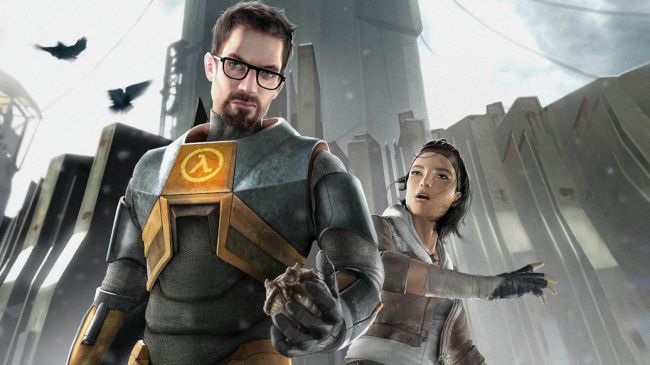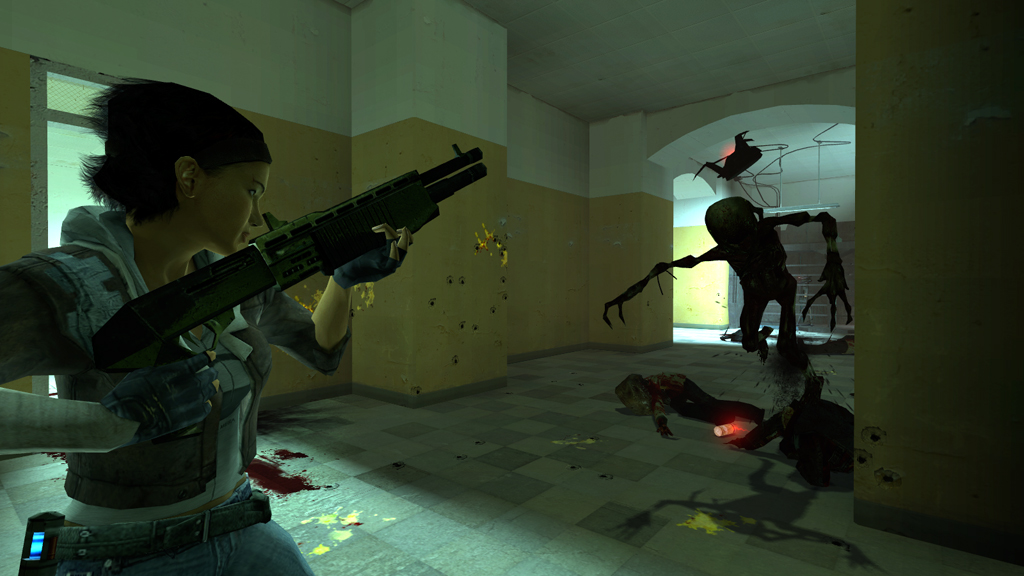Meet the minds behind Half-Life 2
What does it take to make the greatest game of our time?

I’ve noticed that you tend not to integrate storytelling and player action. It’s rare for the player to actually be able to interact with the scripted sequences. Is that a fair observation? Is it just ‘hard’.
ML: Yeah, it is. We can do it, but it requires involving more people in the development process. We do it in Nova Prospekt, when Mossman is putting Eli in the mechanical thing while all the doors are breaking down... We don’t want to do that in every scene, it’s complicated to pull off, and a high point. It has its place. But the gameplay has to be very, very solid. It is what we aim for, though, but those scenes are definitely the hardest to pull off. Compare that scene, which is just action, to the scene where Breen has you captive, and you’re basically just watching theatre. That’s something the level designers and animators could build entirely, without having to wonder “how strong is the gameplay going to have to be to support this?”
BVB: Gordon doesn’t talk, so the player can only participate by picking something up, hitting a button, turning something on, throwing something, shooting something, moving something, breaking something. We’re really taking a lot of that control. We try and keep hyperactive players interested with some little things, so they can bounce around, or look and play with certain toys. It’s funny how some people want to go into the scene and set up the perfect two-shot or three shot on every dialogue, and see exactly what’s happening. Other players just want to smack the characters and jump on their heads.
But there are scenes where it’s much more open, where it’s all about the gameplay, yet the characters interact with you. That’s certainly something we want to expand on, and go much deeper into, in future games that we do.
We’re not creating it, but discovering it as we go.
Marc Laidlaw
One of the interesting quirks of Half-Life is that you never actually complete the story. You never get to explain everything to the player. Why is that?
ML: Part of it is that we’re always creating the world, like we were saying before. Everyone wants to add something to the world. Because the technology changes all the time, and we want to take advantage of that, we don’t want to limit ourselves to hard statements about the world that, maybe a year down the road, we’re suddenly able to make playable, but we’ve screwed ourselves out of doing that because we cut ourselves off a year ago. It’s a function of the medium, I think. We don’t know what we might be able to do tomorrow.
The Seven Hour War, for instance, why show that when, say, in the future we could actually put you through this experience. In a sense, the world extends beyond the narrow limits of the game. It’s a fact of this medium we work in, that we don’t know what the territory is that we can reach next. It’s a function of this technology curve, new areas that are opening up right in front of us. We’re not creating it—we’re discovering it as we go.
The biggest gaming news, reviews and hardware deals
Keep up to date with the most important stories and the best deals, as picked by the PC Gamer team.
BVB: It never occurred to us to stop and put some kind of expository section in the game, that we couldn’t actually support without the player experiencing it. That’s what we’re always trying to support, to keep you in the world. I think part of the fun is telling that story with the environment.

I thought you didn’t finish the world out of deliberate choice. That you wanted to preserve an air of mystery.
ML: More so with Half-Life than Half-Life 2. There is definitely a desire to make the game play out inside people’s heads when they leave their computer. A lot of the fans of the first game, kept wondering about it, telling themselves stories. I don’t mention it because it’s so much part of our mindset in the way we build these games. If we’re going to answer any question, we have to make sure we’re raising even more questions that are even more interesting.
How often do you play-test these scenes? Surely, as they develop, you become immune to their charms?
ML: The cinematic stuff is difficult. Usually, these scenes are a work-in-progress, so the feedback we get can be a little off. And play-testers will like all kinds of things which aren’t necessarily the point of the scene. They don’t like stuff that’s really important to get across. At the beginning of the game, for instance, we felt a lot of the combat started too soon. Play-testers loved it, because they had a gun in their hand, and they were already breaking stuff. It was hard to say, “we shouldn’t do this, yet” because the feedback was really positive. We thought it was too early.
We wanted the combat to start after meeting the couple who are being beaten up by the metrocops. For a while there was more before that, you’d go from instantly being in the lab, to beating up cops. We wanted you to witness the cops doing something horrible, and feel like what you were doing was a response to that—not that you were just a killing machine. Of course the play-testers are going to love this, but they don’t know what notes we’re going for.
You’re fighting against their urges, to an extent?
ML: We have to be extremely clear about what we want to achieve before we go in. We’re testing it to see if they can play the game without getting stuck. Not to see if they enjoy the combat.
BVB: No one ever says “Ohh, you know what. I’d love another emotional scene right here.”
ML: Exactly. People would have been happy just to be given a crowbar in Kleiner’s lab, so they could go around smashing glassware. But they wouldn’t have had the moment where Barney drops it to you. And a lot of people love that moment. We would have had great play-tests if Alyx had given you the crowbar as you enter the lab. But holding it back, holding it back... Players won’t say “Don’t give it to me, yet.” It’s about learning to have faith in the whole arc of the thing. We’re pacing it, holding back for the payoff.

I do adore that moment. It’s such an emotional moment, where you’re suddenly empowered.
ML: Yeah. It’s amazing how those little scenes have the big payoff. That’s one people mention over and over again. It’s the first time in a game, as far as I’m aware, that a character actually gives you a weapon. In the first game we wanted Barney to give you a shotgun, but we could never get it to work. It was like “Dammit, characters are going to hand you your weapons this time. You can either catch it, or it lands on the ground. We’ve been wanting this for years. We’re not leaving a weapon on the ground, ever again.
Bill, you came to Valve from Disney. Does working in an interactive environment offer a different kind of challenge?
BF: It’s a lot harder. In films, you have it all laid out for you. Everything is in there for specific reasons, you have close-ups, you have long-shots, we use them to tell the story. In this medium, we don’t have that to fall back on.
We have to make these characters live in this space. I can’t make my life easier and animate just in close-up. You have no idea how close the player is going to be, you could be trying to create a nice, quiet, tender moment but the camera is right across the other side of the room. Controlling the camera gives you so much more power over emotions. We’re not able to do that—what we try to do is draw you across and closer in, we do it so you feel you need to get in and close to the acting.
But you can’t just concentrate on the facial, like you would want to do in a traditional animation. You’ve got to work on the body-language, too. By the same token, you can’t have them bouncing around if the player is really close to them. You choose your battles. I try and keep it pretty low-key in the more emotional moments. It’s that much more gratifying, we’re creating a character, not a movie clip.

